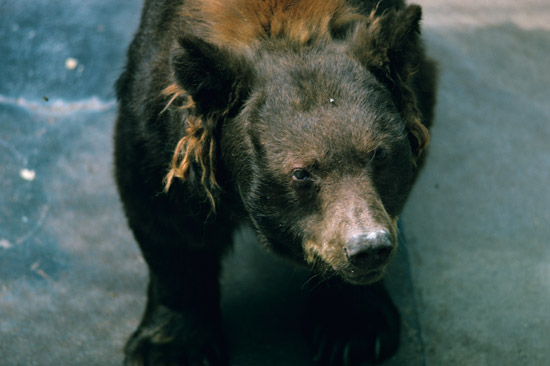Smokey Bear, the Spokesman and National Zoo Highlight
Who said this famous line? “Remember, Only You Can Prevent Forest Fires.” Did you know that Smokey Bear actually lived at the Smithsonian?
/https://tf-cmsv2-smithsonianmag-media.s3.amazonaws.com/filer/20110809103004smokey-bear-1.jpg)
A bear of great distinction was born 67 years ago today. On August 9, 1944, the figure of what would become Smokey Bear began to take shape when Richard Hammett, the director of the Wartime Forest Fire Prevention Program took up pen and set down the characteristics of a short-nose bear—”appealing, knowledgeable, quizzical”—that would become the icon for one of the longest running and most famous advertising campaign slogans of the 20th century.
The first few were clearly duds—”Your Forest, Your Fault, Your Loss,” “Please Mister, Don’t be Careless,” and “Careless Matches Aide the Axis” (more later on that one). None of those roll quite so trippingly off your tongue as “Remember, Only You Can Prevent Forest Fires,” or today’s variant: “Get Your Smokey On, Only You Can Prevent Wildfires.”
Smokey’s story begins during World War II, when a two-man Japanese submarine shelled an oil refinery off the coast of Santa Barbara, California. People began to fear that Japanese submarines could bomb West Coast forests and destroy one of America’s most precious resources—trees that could be turned into rifle cartridges and other valuable war-time products. Forest fire prevention became a goal. Some Mad-Men-style advertising execs were hired to come up with a slogan. That marked the debut of the not-so pithy “Aide the Axis,” as well as “Our Carelessness, Their Secret Weapon.”
Walt Disney’s Bambi got some play in this effort. In 1944, that earnest forest creature appeared on a poster with a beseeching message, “Please Mister, Don’t Be Careless,” but once that campaign ended, forest fire prevention was left without a spokes-animal.
A bear was just what was needed, said Hammett, “perhaps wearing a campaign (or Boy Scout) hat that typifies the outdoors and the woods.” Artist Albert Staehle (1899-1974) got the call because he had a passion for drawing cutesy-type animals. In 1937, he had drafted a devoted mother cow feeding her calf a bottle of Borden’s milk, the first of what would become the long-lashed Elsie the Cow. Staehle’s Smokey Bear poster depicts a well-muscled bear pouring a bucket of water over a campfire with the cautious message: “Smokey Says: Care will prevent 9 out of 10 forest fires.”
Both the bear and the slogan took some time to evolve; sometimes he was fat, other times thin, one time he appeared in a hat that wasn’t regulation. “One year he came out looking like a cross between a bear and a chimpanzee that had eaten too many bananas,” wrote advertising executive Ervin Grant in Boys’ Life in October 1957. Grant is credited with coming up with the “Only You” slogan in 1947.
A forest fire in May 1950 destroyed 17,00o acres in Capitan, New Mexico, and a seriously injured bear cub was found. “When it was all over, we heard this little strange noise and here was this bear cub up in a burned tree,” Forest Service ranger G. W. Chapman told Smithsonian magazine in 2005, Adopted by the Forest Service and awarded the name Smokey, the bear a month later came to live at the Zoo. Fan letters arrived with such frequency, the Post Office decided the Zoo’s new fire prevention celeb need his very own zip code—20252.
“Smokey was an instant success from 1950 until his death in 1976,” says Pam Henson, the director of the Smithsonian’s Institutional History Division. “He was the recipient of hundreds of gifts of honey and money, about 5,000 letters each week poured in from people all over the country.
Smokey Bear lived a long and happy life at the Zoo and even took a wife. Earnest zoo keepers introduced him to a female name “Goldie” in 1962. (The pair never actually hit it off and no little cubs ever came of the match.) Smokey Bear died in November 8, 1976 and was widely eulogized. Albert Staehle, for his part, was paid tribute in the Congressional Record in 1994. The Zoo also had a second Smokey Bear on view.
“Smokey Bear was really a national icon for several generations,” says Henson. “When I was five years old in 1953, I broke my arm. To console me, I was allowed to pick out a toy and I chose a Smokey Bear stuffed animal, complete with uniform, badge, ranger hat and shovel. It was my favorite toy for many years. So of course, when I came to Washington and visited the National Zoo, Smokey Bear was my first choice to go see.”
/https://tf-cmsv2-smithsonianmag-media.s3.amazonaws.com/accounts/headshot/Beth_Head_Shot_High_Res-14-v2.png)

/https://tf-cmsv2-smithsonianmag-media.s3.amazonaws.com/accounts/headshot/Beth_Head_Shot_High_Res-14-v2.png)